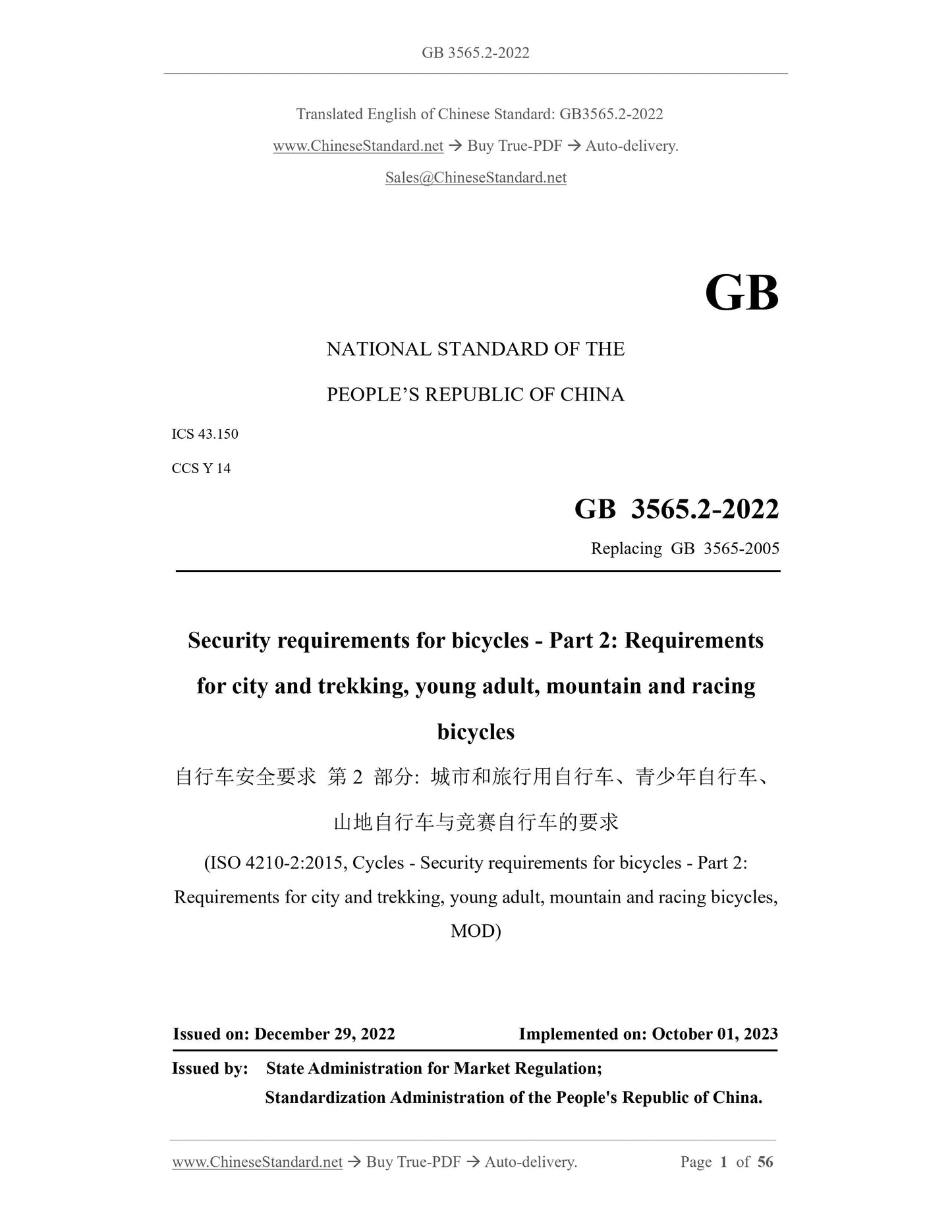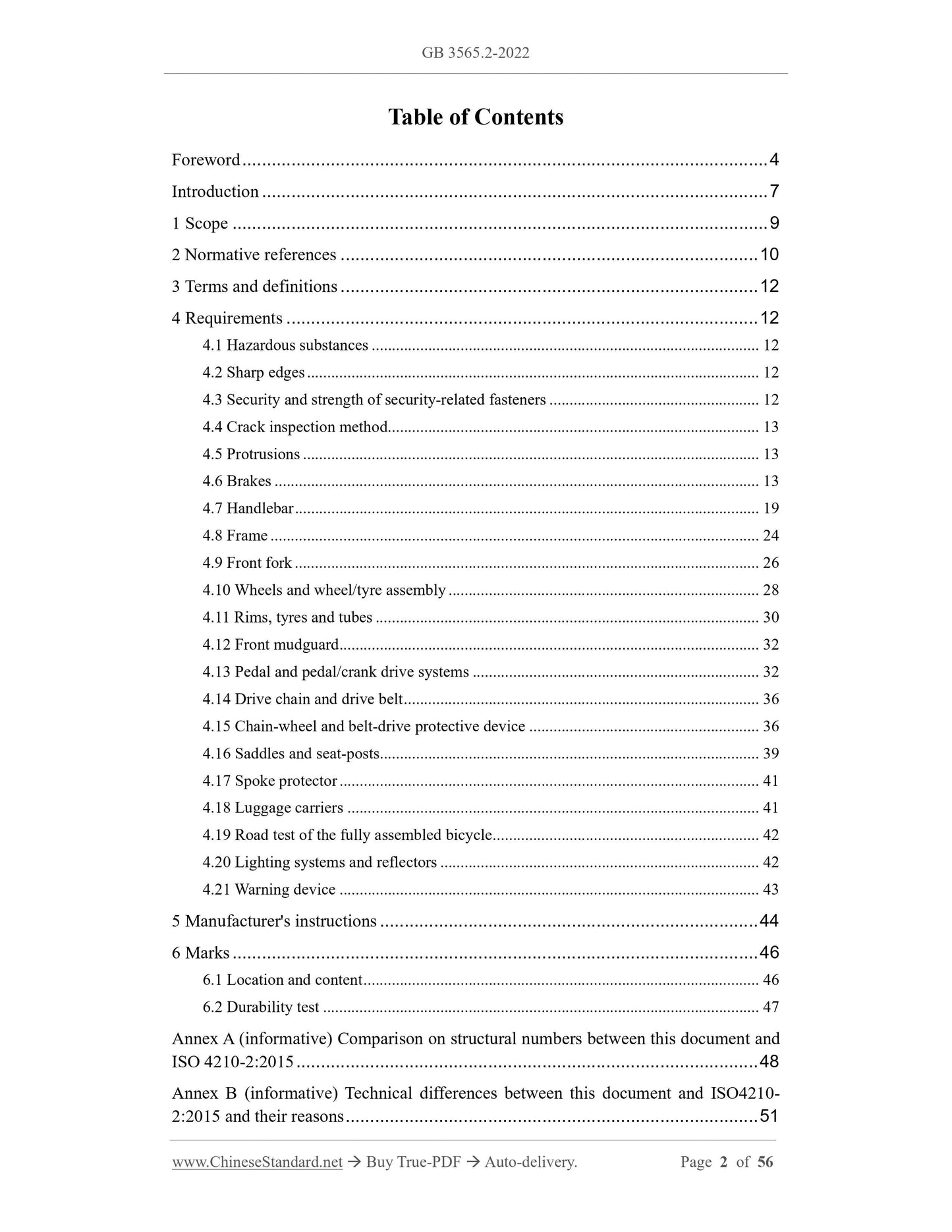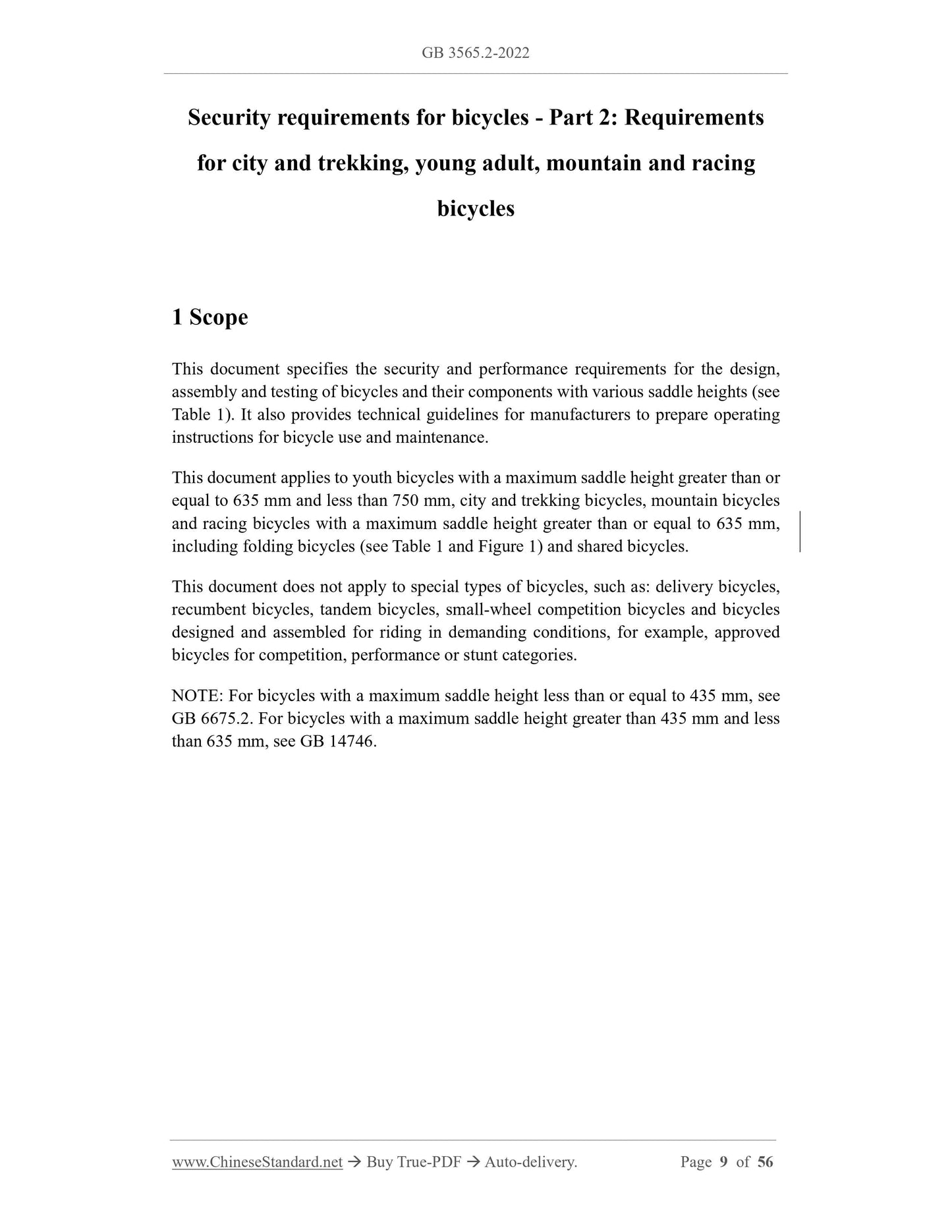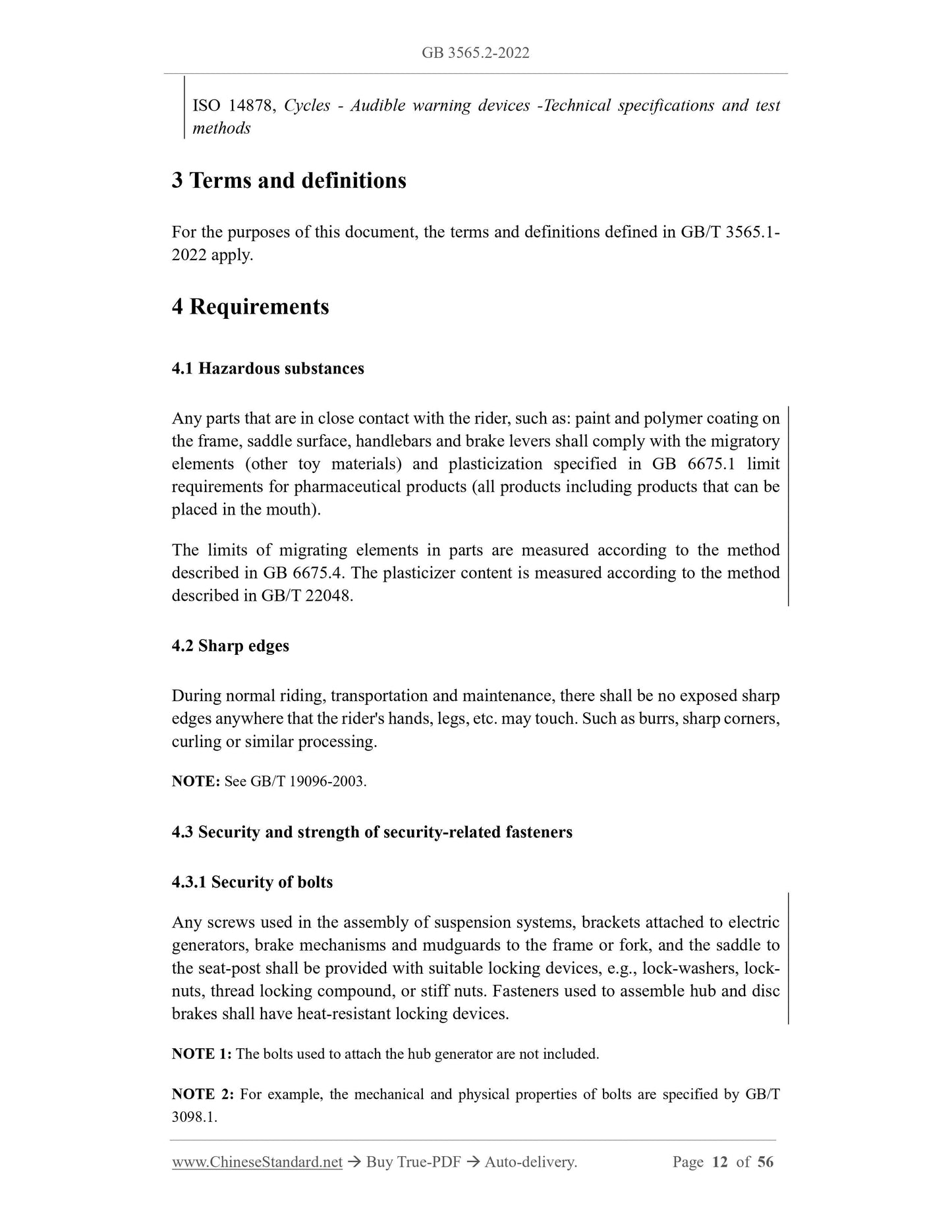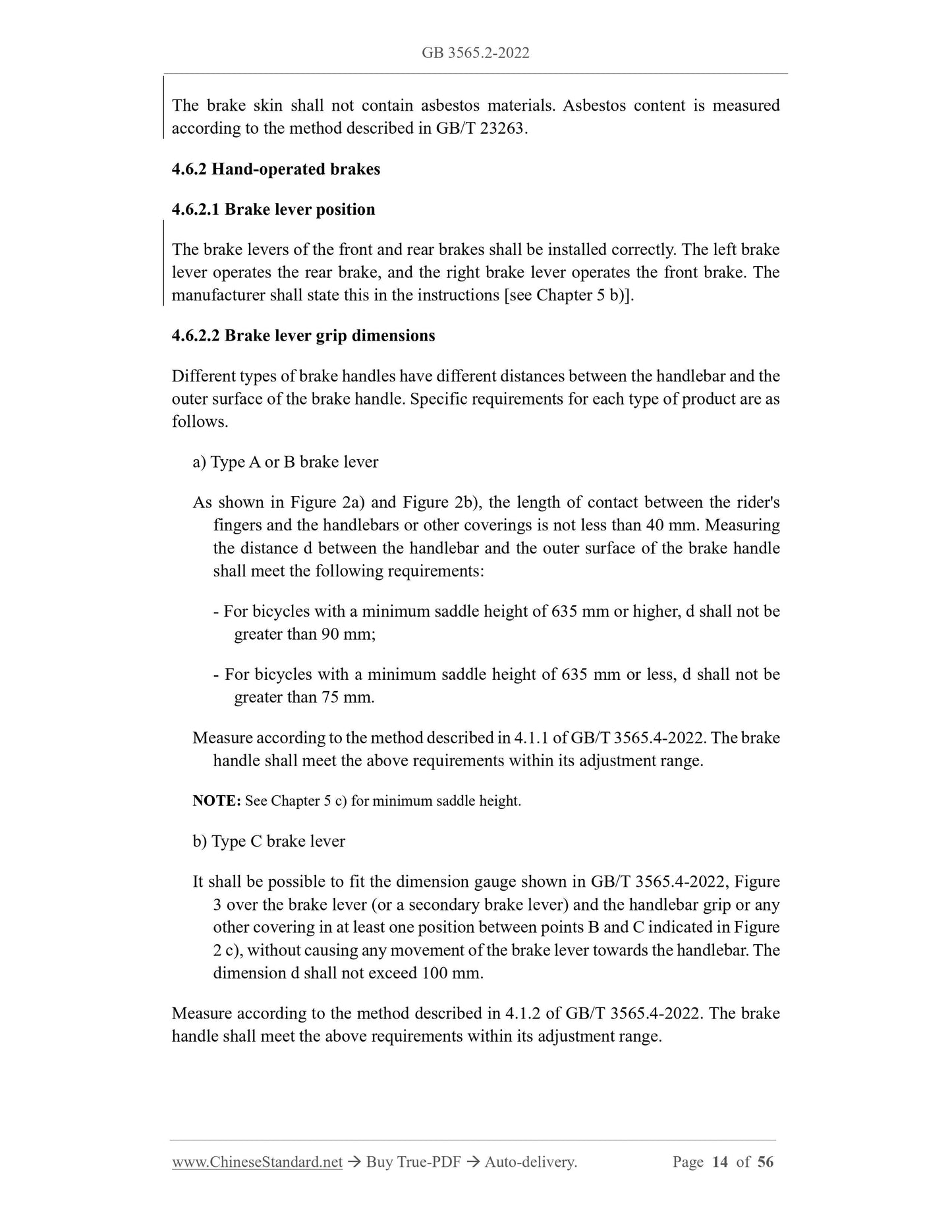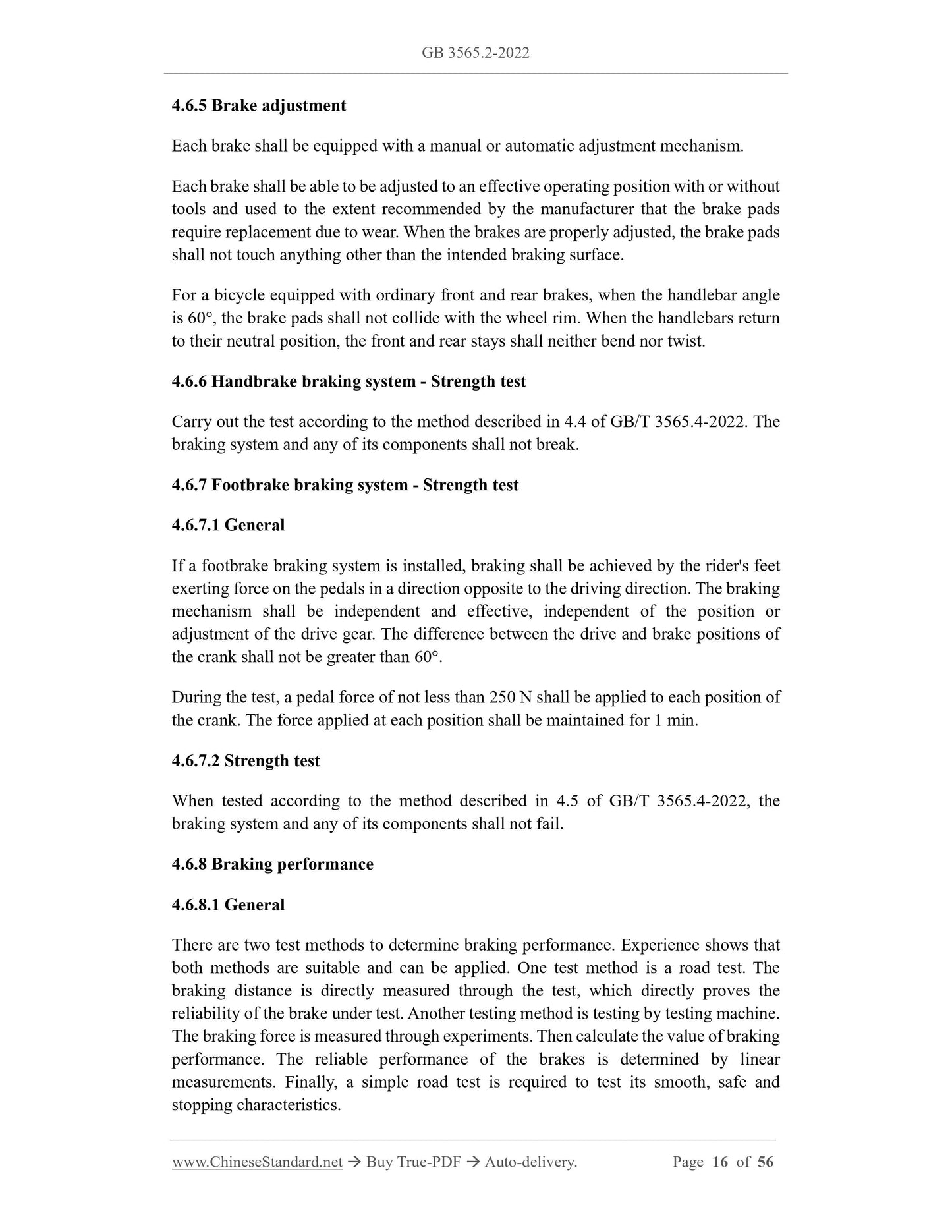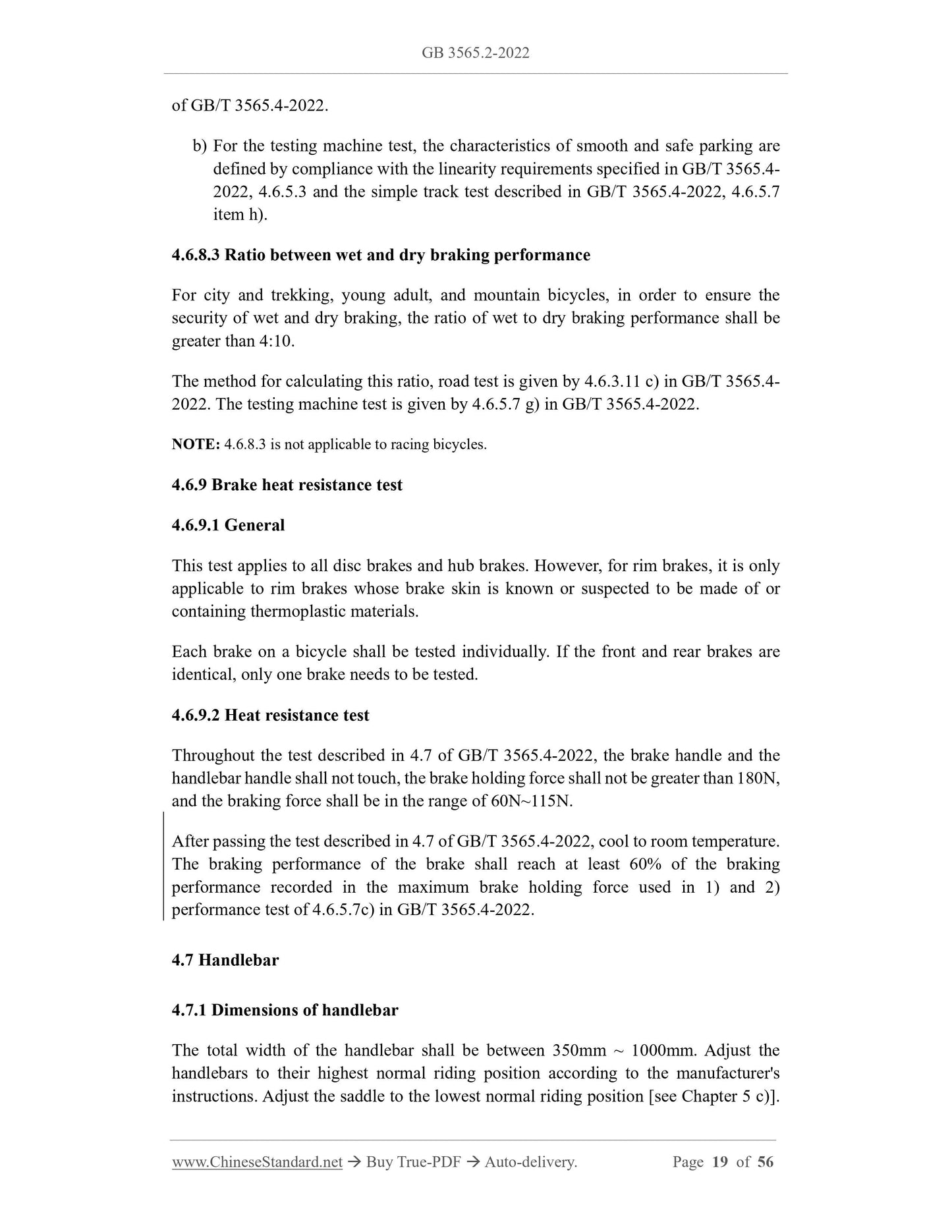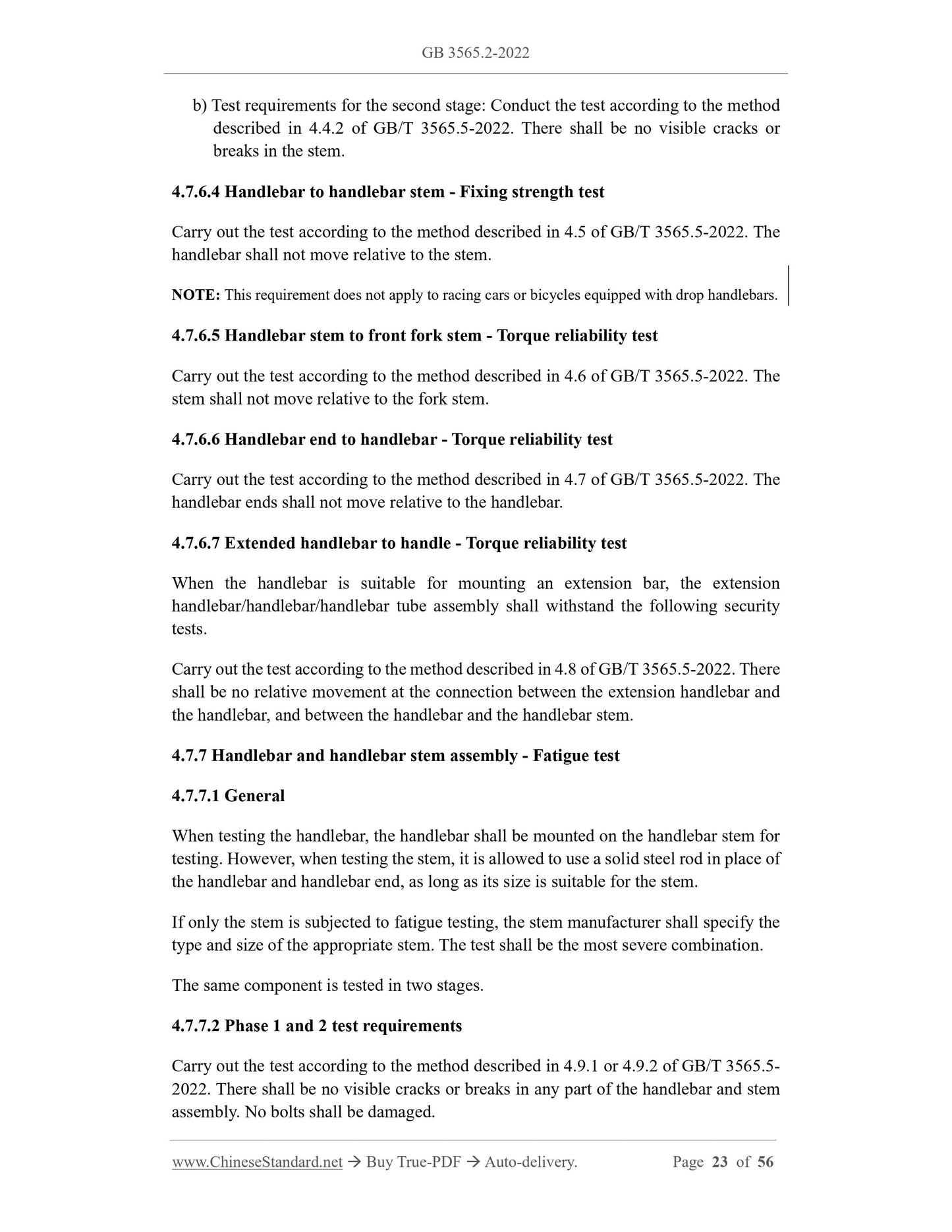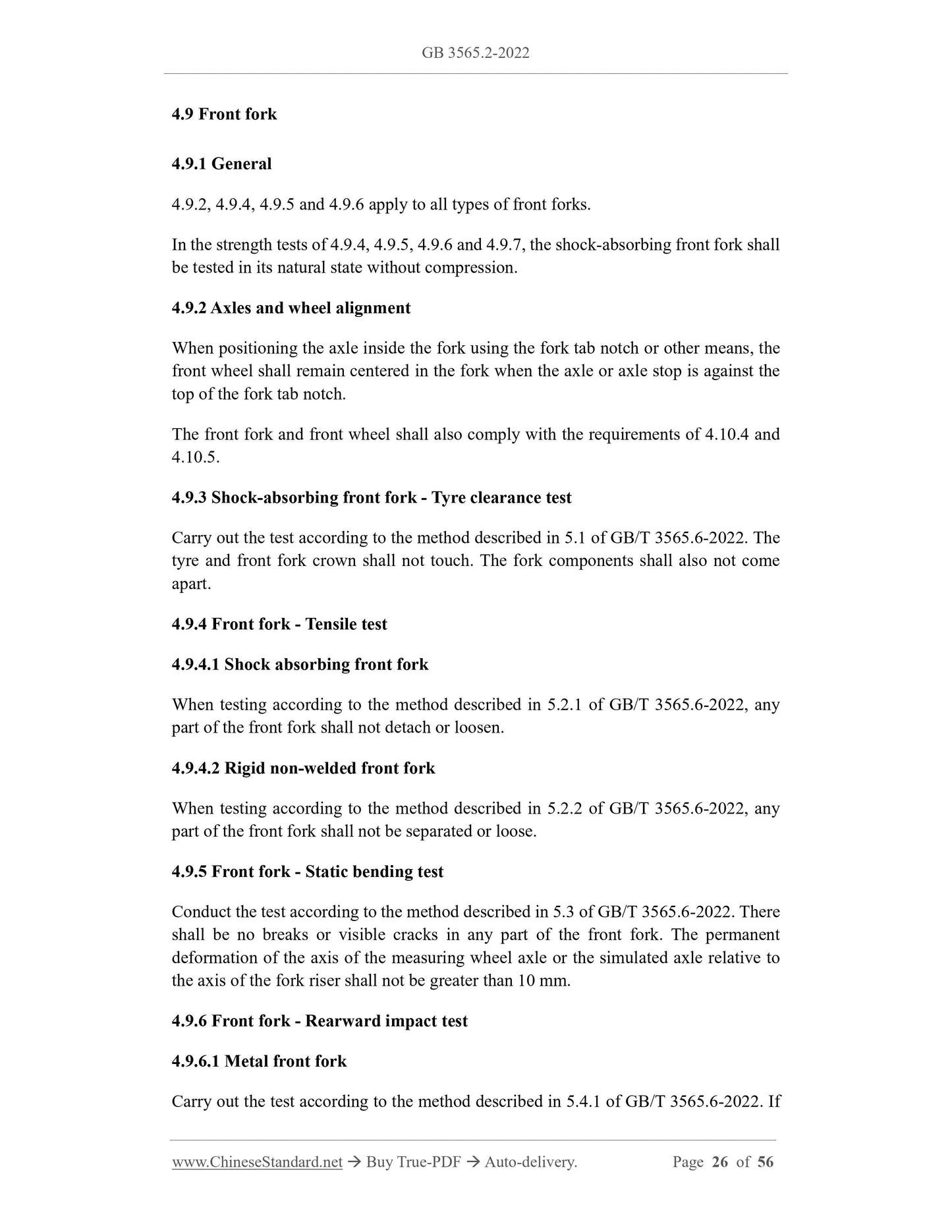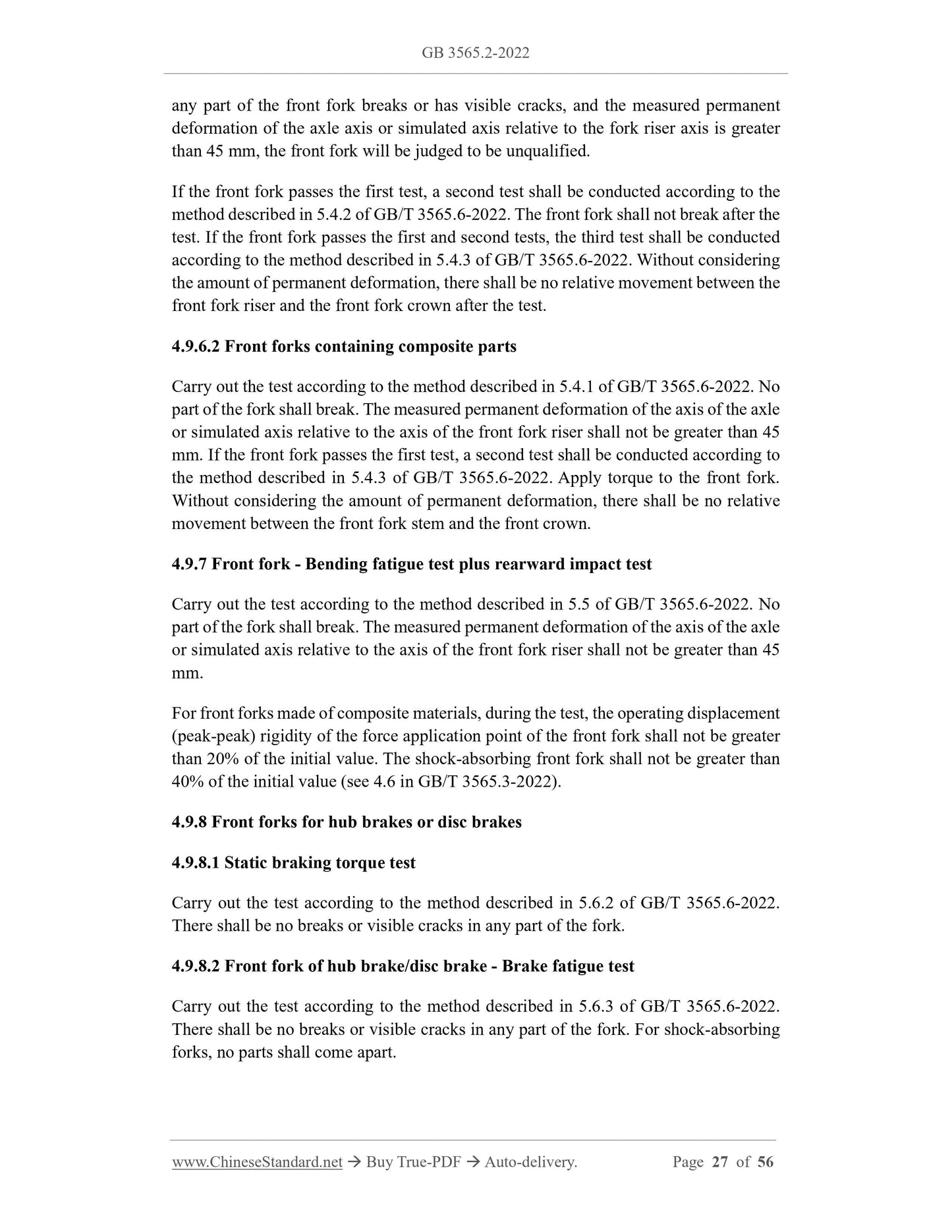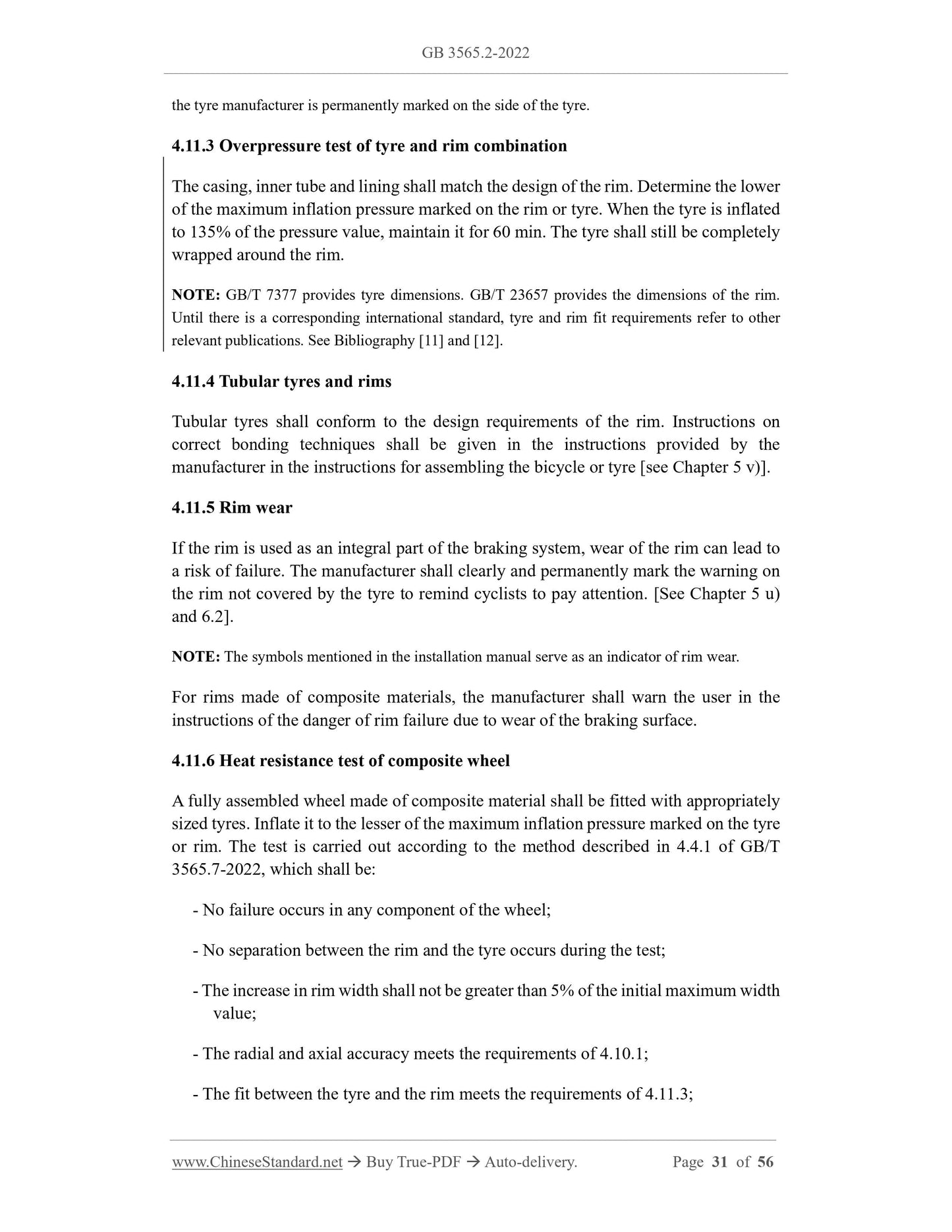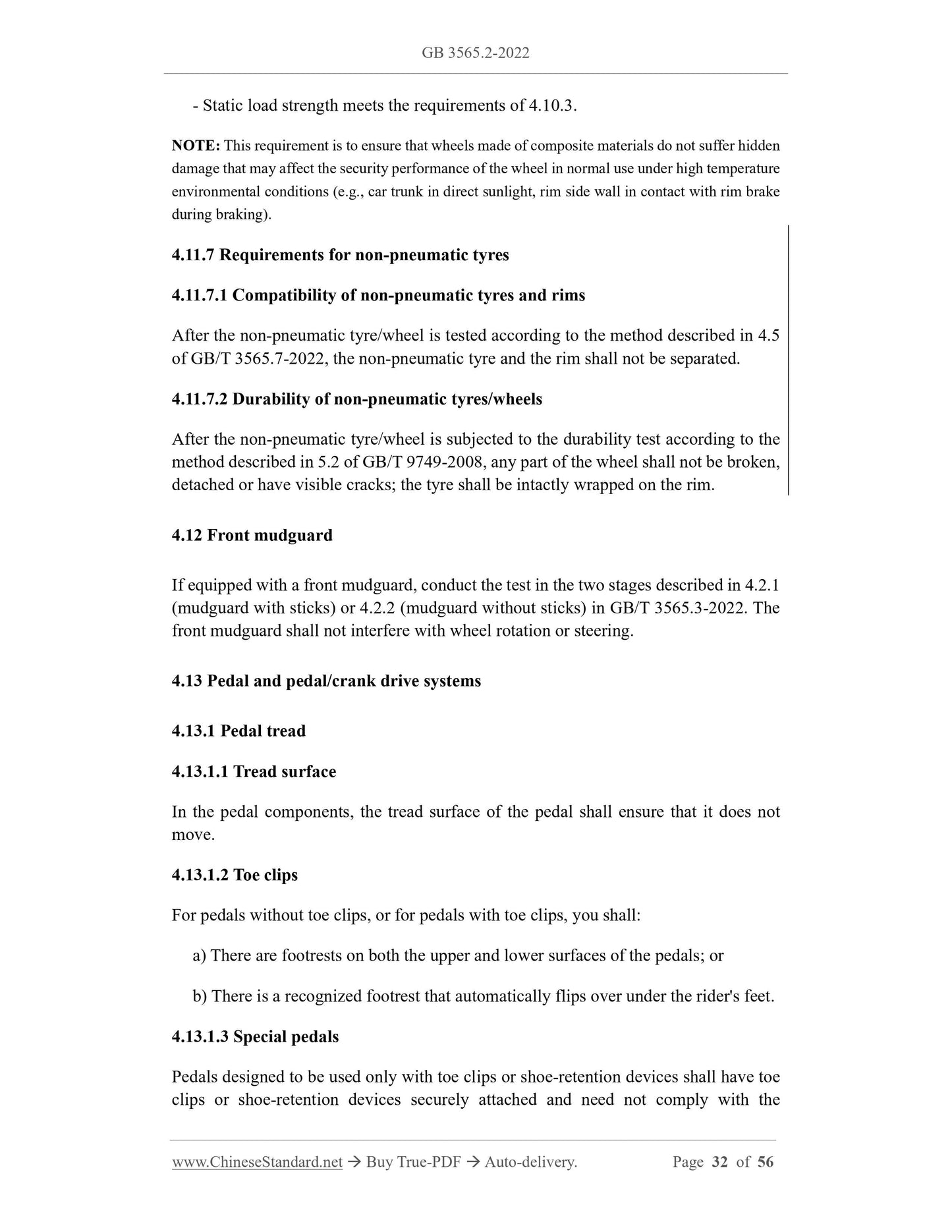1
/
of
12
PayPal, credit cards. Download editable-PDF and invoice in 1 second!
GB 3565.2-2022 English PDF
GB 3565.2-2022 English PDF
Regular price
$680.00 USD
Regular price
Sale price
$680.00 USD
Unit price
/
per
Shipping calculated at checkout.
Couldn't load pickup availability
Delivery: 3 seconds. Download true-PDF + Invoice.
Get QUOTATION in 1-minute: Click GB 3565.2-2022
Historical versions: GB 3565.2-2022
Preview True-PDF (Reload/Scroll if blank)
GB 3565.2-2022: Safety requirements for bicycles -- Part 2: Requirements for city and trekking, young adult, mountain and racing bicycles
GB 3565.2-2022
GB
NATIONAL STANDARD OF THE
PEOPLE’S REPUBLIC OF CHINA
ICS 43.150
CCS Y 14
Replacing GB 3565-2005
Security requirements for bicycles - Part 2: Requirements
for city and trekking, young adult, mountain and racing
bicycles
(ISO 4210-2:2015, Cycles - Security requirements for bicycles - Part 2:
Requirements for city and trekking, young adult, mountain and racing bicycles,
MOD)
ISSUED ON: DECEMBER 29, 2022
IMPLEMENTED ON: OCTOBER 01, 2023
Issued by: State Administration for Market Regulation;
Standardization Administration of the People's Republic of China.
Table of Contents
Foreword ... 4
Introduction ... 7
1 Scope ... 9
2 Normative references ... 10
3 Terms and definitions ... 12
4 Requirements ... 12
4.1 Hazardous substances ... 12
4.2 Sharp edges ... 12
4.3 Security and strength of security-related fasteners ... 12
4.4 Crack inspection method ... 13
4.5 Protrusions ... 13
4.6 Brakes ... 13
4.7 Handlebar ... 19
4.8 Frame ... 24
4.9 Front fork ... 26
4.10 Wheels and wheel/tyre assembly ... 28
4.11 Rims, tyres and tubes ... 30
4.12 Front mudguard ... 32
4.13 Pedal and pedal/crank drive systems ... 32
4.14 Drive chain and drive belt ... 36
4.15 Chain-wheel and belt-drive protective device ... 36
4.16 Saddles and seat-posts... 39
4.17 Spoke protector ... 41
4.18 Luggage carriers ... 41
4.19 Road test of the fully assembled bicycle ... 42
4.20 Lighting systems and reflectors ... 42
4.21 Warning device ... 43
5 Manufacturer's instructions ... 44
6 Marks ... 46
6.1 Location and content ... 46
6.2 Durability test ... 47
Annex A (informative) Comparison on structural numbers between this document and
ISO 4210-2:2015 ... 48
Annex B (informative) Technical differences between this document and ISO4210-
2:2015 and their reasons ... 51
Security requirements for bicycles - Part 2: Requirements
for city and trekking, young adult, mountain and racing
bicycles
1 Scope
This document specifies the security and performance requirements for the design,
assembly and testing of bicycles and their components with various saddle heights (see
Table 1). It also provides technical guidelines for manufacturers to prepare operating
instructions for bicycle use and maintenance.
This document applies to youth bicycles with a maximum saddle height greater than or
equal to 635 mm and less than 750 mm, city and trekking bicycles, mountain bicycles
and racing bicycles with a maximum saddle height greater than or equal to 635 mm,
including folding bicycles (see Table 1 and Figure 1) and shared bicycles.
This document does not apply to special types of bicycles, such as: delivery bicycles,
recumbent bicycles, tandem bicycles, small-wheel competition bicycles and bicycles
designed and assembled for riding in demanding conditions, for example, approved
bicycles for competition, performance or stunt categories.
NOTE: For bicycles with a maximum saddle height less than or equal to 435 mm, see
GB 6675.2. For bicycles with a maximum saddle height greater than 435 mm and less
than 635 mm, see GB 14746.
ISO 14878, Cycles - Audible warning devices -Technical specifications and test
methods
3 Terms and definitions
For the purposes of this document, the terms and definitions defined in GB/T 3565.1-
2022 apply.
4 Requirements
4.1 Hazardous substances
Any parts that are in close contact with the rider, such as: paint and polymer coating on
the frame, saddle surface, handlebars and brake levers shall comply with the migratory
elements (other toy materials) and plasticization specified in GB 6675.1 limit
requirements for pharmaceutical products (all products including products that can be
placed in the mouth).
The limits of migrating elements in parts are measured according to the method
described in GB 6675.4. The plasticizer content is measured according to the method
described in GB/T 22048.
4.2 Sharp edges
During normal riding, transportation and maintenance, there shall be no exposed sharp
edges anywhere that the rider's hands, legs, etc. may touch. Such as burrs, sharp corners,
curling or similar processing.
NOTE: See GB/T 19096-2003.
4.3 Security and strength of security-related fasteners
4.3.1 Security of bolts
Any screws used in the assembly of suspension systems, brackets attached to electric
generators, brake mechanisms and mudguards to the frame or fork, and the saddle to
the seat-post shall be provided with suitable locking devices, e.g., lock-washers, lock-
nuts, thread locking compound, or stiff nuts. Fasteners used to assemble hub and disc
brakes shall have heat-resistant locking devices.
NOTE 1: The bolts used to attach the hub generator are not included.
NOTE 2: For example, the mechanical and physical properties of bolts are specified by GB/T
3098.1.
The brake skin shall not contain asbestos materials. Asbestos content is measured
according to the method described in GB/T 23263.
4.6.2 Hand-operated brakes
4.6.2.1 Brake lever position
The brake levers of the front and rear brakes shall be installed correctly. The left brake
lever operates the rear brake, and the right brake lever operates the front brake. The
manufacturer shall state this in the instructions [see Chapter 5 b)].
4.6.2.2 Brake lever grip dimensions
Different types of brake handles have different distances between the handlebar and the
outer surface of the brake handle. Specific requirements for each type of product are as
follows.
a) Type A or B brake lever
As shown in Figure 2a) and Figure 2b), the length of contact between the rider's
fingers and the handlebars or other coverings is not less than 40 mm. Measuring
the distance d between the handlebar and the outer surface of the brake handle
shall meet the following requirements:
- For bicycles with a minimum saddle height of 635 mm or higher, d shall not be
greater than 90 mm;
- For bicycles with a minimum saddle height of 635 mm or less, d shall not be
greater than 75 mm.
Measure according to the method described in 4.1.1 of GB/T 3565.4-2022. The brake
handle shall meet the above requirements within its adjustment range.
NOTE: See Chapter 5 c) for minimum saddle height.
b) Type C brake lever
It shall be possible to fit the dimension gauge shown in GB/T 3565.4-2022, Figure
3 over the brake lever (or a secondary brake lever) and the handlebar grip or any
other covering in at least one position between points B and C indicated in Figure
2 c), without causing any movement of the brake lever towards the handlebar. The
dimension d shall not exceed 100 mm.
Measure according to the method described in 4.1.2 of GB/T 3565.4-2022. The brake
handle shall meet the above requirements within its adjustment range.
4.6.5 Brake adjustment
Each brake shall be equipped with a manual or automatic adjustment mechanism.
Each brake shall be able to be adjusted to an effective operating position with or without
tools and used to the extent recommended by the manufacturer that the brake pads
require replacement due to wear. When the brakes are properly adjusted, the brake pads
shall not touch anything other than the intended braking surface.
For a bicycle equipped with ordinary front and rear brakes, when the handlebar angle
is 60°, the brake pads shall not collide with the wheel rim. When the handlebars return
to their neutral position, the front and rear stays shall neither bend nor ...
Get QUOTATION in 1-minute: Click GB 3565.2-2022
Historical versions: GB 3565.2-2022
Preview True-PDF (Reload/Scroll if blank)
GB 3565.2-2022: Safety requirements for bicycles -- Part 2: Requirements for city and trekking, young adult, mountain and racing bicycles
GB 3565.2-2022
GB
NATIONAL STANDARD OF THE
PEOPLE’S REPUBLIC OF CHINA
ICS 43.150
CCS Y 14
Replacing GB 3565-2005
Security requirements for bicycles - Part 2: Requirements
for city and trekking, young adult, mountain and racing
bicycles
(ISO 4210-2:2015, Cycles - Security requirements for bicycles - Part 2:
Requirements for city and trekking, young adult, mountain and racing bicycles,
MOD)
ISSUED ON: DECEMBER 29, 2022
IMPLEMENTED ON: OCTOBER 01, 2023
Issued by: State Administration for Market Regulation;
Standardization Administration of the People's Republic of China.
Table of Contents
Foreword ... 4
Introduction ... 7
1 Scope ... 9
2 Normative references ... 10
3 Terms and definitions ... 12
4 Requirements ... 12
4.1 Hazardous substances ... 12
4.2 Sharp edges ... 12
4.3 Security and strength of security-related fasteners ... 12
4.4 Crack inspection method ... 13
4.5 Protrusions ... 13
4.6 Brakes ... 13
4.7 Handlebar ... 19
4.8 Frame ... 24
4.9 Front fork ... 26
4.10 Wheels and wheel/tyre assembly ... 28
4.11 Rims, tyres and tubes ... 30
4.12 Front mudguard ... 32
4.13 Pedal and pedal/crank drive systems ... 32
4.14 Drive chain and drive belt ... 36
4.15 Chain-wheel and belt-drive protective device ... 36
4.16 Saddles and seat-posts... 39
4.17 Spoke protector ... 41
4.18 Luggage carriers ... 41
4.19 Road test of the fully assembled bicycle ... 42
4.20 Lighting systems and reflectors ... 42
4.21 Warning device ... 43
5 Manufacturer's instructions ... 44
6 Marks ... 46
6.1 Location and content ... 46
6.2 Durability test ... 47
Annex A (informative) Comparison on structural numbers between this document and
ISO 4210-2:2015 ... 48
Annex B (informative) Technical differences between this document and ISO4210-
2:2015 and their reasons ... 51
Security requirements for bicycles - Part 2: Requirements
for city and trekking, young adult, mountain and racing
bicycles
1 Scope
This document specifies the security and performance requirements for the design,
assembly and testing of bicycles and their components with various saddle heights (see
Table 1). It also provides technical guidelines for manufacturers to prepare operating
instructions for bicycle use and maintenance.
This document applies to youth bicycles with a maximum saddle height greater than or
equal to 635 mm and less than 750 mm, city and trekking bicycles, mountain bicycles
and racing bicycles with a maximum saddle height greater than or equal to 635 mm,
including folding bicycles (see Table 1 and Figure 1) and shared bicycles.
This document does not apply to special types of bicycles, such as: delivery bicycles,
recumbent bicycles, tandem bicycles, small-wheel competition bicycles and bicycles
designed and assembled for riding in demanding conditions, for example, approved
bicycles for competition, performance or stunt categories.
NOTE: For bicycles with a maximum saddle height less than or equal to 435 mm, see
GB 6675.2. For bicycles with a maximum saddle height greater than 435 mm and less
than 635 mm, see GB 14746.
ISO 14878, Cycles - Audible warning devices -Technical specifications and test
methods
3 Terms and definitions
For the purposes of this document, the terms and definitions defined in GB/T 3565.1-
2022 apply.
4 Requirements
4.1 Hazardous substances
Any parts that are in close contact with the rider, such as: paint and polymer coating on
the frame, saddle surface, handlebars and brake levers shall comply with the migratory
elements (other toy materials) and plasticization specified in GB 6675.1 limit
requirements for pharmaceutical products (all products including products that can be
placed in the mouth).
The limits of migrating elements in parts are measured according to the method
described in GB 6675.4. The plasticizer content is measured according to the method
described in GB/T 22048.
4.2 Sharp edges
During normal riding, transportation and maintenance, there shall be no exposed sharp
edges anywhere that the rider's hands, legs, etc. may touch. Such as burrs, sharp corners,
curling or similar processing.
NOTE: See GB/T 19096-2003.
4.3 Security and strength of security-related fasteners
4.3.1 Security of bolts
Any screws used in the assembly of suspension systems, brackets attached to electric
generators, brake mechanisms and mudguards to the frame or fork, and the saddle to
the seat-post shall be provided with suitable locking devices, e.g., lock-washers, lock-
nuts, thread locking compound, or stiff nuts. Fasteners used to assemble hub and disc
brakes shall have heat-resistant locking devices.
NOTE 1: The bolts used to attach the hub generator are not included.
NOTE 2: For example, the mechanical and physical properties of bolts are specified by GB/T
3098.1.
The brake skin shall not contain asbestos materials. Asbestos content is measured
according to the method described in GB/T 23263.
4.6.2 Hand-operated brakes
4.6.2.1 Brake lever position
The brake levers of the front and rear brakes shall be installed correctly. The left brake
lever operates the rear brake, and the right brake lever operates the front brake. The
manufacturer shall state this in the instructions [see Chapter 5 b)].
4.6.2.2 Brake lever grip dimensions
Different types of brake handles have different distances between the handlebar and the
outer surface of the brake handle. Specific requirements for each type of product are as
follows.
a) Type A or B brake lever
As shown in Figure 2a) and Figure 2b), the length of contact between the rider's
fingers and the handlebars or other coverings is not less than 40 mm. Measuring
the distance d between the handlebar and the outer surface of the brake handle
shall meet the following requirements:
- For bicycles with a minimum saddle height of 635 mm or higher, d shall not be
greater than 90 mm;
- For bicycles with a minimum saddle height of 635 mm or less, d shall not be
greater than 75 mm.
Measure according to the method described in 4.1.1 of GB/T 3565.4-2022. The brake
handle shall meet the above requirements within its adjustment range.
NOTE: See Chapter 5 c) for minimum saddle height.
b) Type C brake lever
It shall be possible to fit the dimension gauge shown in GB/T 3565.4-2022, Figure
3 over the brake lever (or a secondary brake lever) and the handlebar grip or any
other covering in at least one position between points B and C indicated in Figure
2 c), without causing any movement of the brake lever towards the handlebar. The
dimension d shall not exceed 100 mm.
Measure according to the method described in 4.1.2 of GB/T 3565.4-2022. The brake
handle shall meet the above requirements within its adjustment range.
4.6.5 Brake adjustment
Each brake shall be equipped with a manual or automatic adjustment mechanism.
Each brake shall be able to be adjusted to an effective operating position with or without
tools and used to the extent recommended by the manufacturer that the brake pads
require replacement due to wear. When the brakes are properly adjusted, the brake pads
shall not touch anything other than the intended braking surface.
For a bicycle equipped with ordinary front and rear brakes, when the handlebar angle
is 60°, the brake pads shall not collide with the wheel rim. When the handlebars return
to their neutral position, the front and rear stays shall neither bend nor ...
Share
